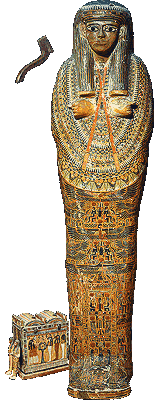| Egyptian Afterlife | Daily Life |
Mummification
| Mummification Explained |
Anubis - the god of Mummification |
Wrapping the Mummy |
| Mummified Menagerie | The Ka and the Ba |

The process of mummification, the form of embalming practiced by the ancient Egyptians, changed over time from the Old Kingdom (ca. 2750-2250 BC), when it was available only to kings, to the New Kingdom (ca. 1539-1070 BC), when it was available to everyone. The level of mummification depended on what one could afford. The most fully developed form involved four basic steps:
DID YOU KNOW: The people who wrapped mummies were called 'wetu' - the Egyptian word for 'bandagers'.
The afterlife was assured by:
The Egyptians preserved their dead by a process called mummification. It was thought to allow people to live forever after death. The Egyptians believed that everyone had a Ka and a Ba. The Ka was the person's double, or soul and the Ba was like the spirit. In order to live forever, the Ka and Ba needed to be reunited in the body after death. So it was important to stop the body rotting. A decayed body meant an unhappy Ka - and misery in the afterlife. Poor people were buried in the desert where the sand dried their bodies. Food, tools and jewellery were laid beside them for the use in the kingdom of Osiris. The wealthy could afford to have their bodies mummified and placed with their possessions in special tombs. The coffins were enclosed in large stone boxes, which were later called sarcophagi, to protect them from tomb robbers or attacks from hungry wild animals.
Mummification is the process of slowly drying a dead body to stop it rotting. In ancient Egypt, the process took about 70 days.
DID YOU KNOW: In the sixteenth century, ground-up mummies were used in European medicines. One French king took a mixture of mummy and powdered rhubarb to cure his battle wounds. It made him violently ill.
![]()
Mummified Menagerie

People thought that animals were messengers of the gods and many were mummified including calves, crocodiles and cats. Thousands of mummified cats were found in many tombs. In the nineteenth century, about 300,000 cat mummies were shipped to England where they were ground up into garden fertiliser and sold by the tonne.
Animals were part of the Egyptian household. When a pet cat died, the whole family shaved off their eyebrows as a sign of mourning.
DID YOU KNOW: Mummies got their names from Arab invaders thought Egyptian mummies had been preserved in 'mummiya' - a kind of tar.
DID YOU KNOW: Anyone who killed a cat could be punished by death. When a cat died, some families even took their beloved pet's body to the city of Bubastis, the centre of worship for the cat goddess Bastet. Here the dead cat was embalmed, wrapped and laid in a special cat shaped coffin before being buried in a cat cemetery.
![]()
Wrapping the Mummy
|
|
First the head and neck are wrapped with strips of fine linen. Then the fingers and the toes are individually wrapped.
|
| The arms and legs are wrapped separately. Between the layers of wrapping, the embalmers place charms, called amulets to protect the body in its journey through the underworld. |
A priest reads spells out loud while the mummy is being wrapped. These spells will help ward off evil spirits and help the deceased make the journey to the afterlife.
The arms and legs are tied together. A papyrus scroll with spells from the Book of the Dead is placed between the wrapped hands.
More linen strips are wrapped around the body. At every layer, the bandages are painted with liquid resin that helps to glue the bandages together.
A cloth is wrapped around the body and a picture of the god Osiris is painted on its surface.

Finally, a large cloth is wrapped around the entire mummy. It is attached with strips of linen that run from the top to the bottom of the mummy, and around its middle.
A board of painted wood is placed on top of the mummy before the mummy is lowered into its coffin. The first coffin is then put inside a second coffin.
The funeral is held for the deceased and his family mourns.
A ritual called the 'Opening of the Mouth' is performed, allowing the deceased to eat and drink again.
Finally, the body and its coffins are placed inside a large stone sarcophagus in the tomb. Furniture, clothing, valuable objects, food and drink are arranged in the tomb for the deceased.

Now the mummy's body is ready for its journey through the underworld. There the heart will be judged by the mummy's good deeds on earth. If the mummy's heart is found to be pure then the mummy will be sent to live for all eternity in the beautiful 'Field of Reeds'.
DID YOU KNOW: The ancient Egyptians believed that the land of the dead lay in the west, where the sun set. Most Egyptian cemeteries, including the Valley of the Kings, were situated on the west bank of the River Nile. One of the names for Osiris, the god of the dead, was "Foremost of the Westerners".
![]()
Egyptian religion held that what we call the spirit or soul consisted of three distinct parts: the Ka, the Ba, and the ankh. Egyptologists characterise the ka (represented by two upraised arms) as the individual's "vital force" or "spiritual twin." When a person was born, the god Khnum created his or her Ka, modelling both body and spirit on his potter's wheel. Kings could have several kas; mere mortals had only one. During life the ka remained separate from the body. At death a person was said to have "gone to his [or her] Ka." This was the Egyptian way of saying that the Ka had merged with the deceased's lifeless form.
To survive, the Ka needed a body for its eternal home. The Egyptians believed that the Ka dwelt within either the mummy or the tomb statue (sometimes called the Ka-statue), a spare body needed if the corpse should be destroyed.
The Egyptians called the second element of the soul the Ba (or "animation"). It was the part of the spirit that was free to leave the tomb and travel about the earth during the day. The Ba was obliged, however, to return to the tomb during the perilous hours of darkness. Artisans had several ways of showing the Ba, sometimes as a bird, but most often as a human-headed bird. The Ba came into being only when the Ka and the dead body were united; without the Ka and a mummy or Ka-statue, the Ba could not exist.
DID YOU KNOW: Modern technology allows scientists to examine mummies without opening the coffins or damaging the bodies. At Saint Thomas' Hospital in London, England, the body of Tjentmutengebtiu, a 20 year old woman, was analysed with the help of an advanced X-ray process called CAT scanning.
| Egyptian Afterlife | Daily Life |